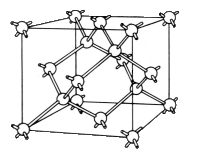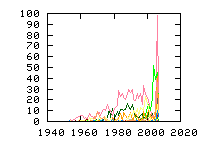Showing
10, 25, 50, 100, 500, 1000, all papers per page.
Sort by:
last publication date,
older publication date,
last update date.
- 1. Appl. Phys. Lett. 89, 092120 (2006) , “Defect generation at SiO2/Si interfaces by low pressure chemical vapor deposition of silicon nitride”, Hao Jin, K. J. Weber, and P. J. SmithLow pressure chemical vapor deposition of Si3N4 on oxidized Si (111) surfaces causes a change in the properties of the dominant interface defect, the Pb center, observed by electron paramagnetic resonance. The change in the signature of the... (Read more)
- 2. Phys. Rev. Lett. 92, 105505 (2004) , “In situ ESR Observation of Interface Dangling Bond Formation Processes During Ultrathin SiO2 Growth on Si(111)”, W. Futako, N. Mizuochi, and S. YamasakiWe report the formation processes of interface dangling bonds (Pb centers) during initial oxidation of a clean Si(111) surface using an ultrahigh-vacuum electron-spin-resonance technique. At the oxidation of one or two Si layer(s), the Pb center... (Read more)
- 3. Phys. Rev. Lett. 86, 1054 (2001) , “Electron Spin Resonance Observation of the Si(111)- (7?7) Surface and Its Oxidation Process”, Takahide Umeda, Masayasu Nishizawa, Tetsuji Yasuda, Junichi Isoya, Satoshi Yamasaki, and Kazunobu TanakaElectron spin resonance (ESR) observation of dangling-bond states on the Si(111)- (7?7) surface is demonstrated for the first time. The ESR spectra clearly show that a reaction of molecular oxygen with the Si(111)- (7?7) surface is associated with the appearance of a new dangling-bond center at... (Read more)Si SiO2| EPR STM/AFM/SPM| Oxygen Pb Ps0 Ps1 Silicon dangling-bond interface surface .inp files: Si/surface(111) | last update: Masatoshi Sasaki
- 4. Phys. Rev. B 61, 8393-8403 (2000) , “Dissociation Kinetics of Hydrogen-Passivated Pb Defects at the (111)Si/SiO2 Interface”, A. Stesmans.An electron-spin-resonance study has been carried out, both isothermally and isochronically, of the recovery under vacuum annealing from the hydrogen passivated state (symbolized as HPb) of paramagnetic Pb centers (Si3?Si?) at the (111)Si/SiO2... (Read more)
- 5. Phys. Rev. B 61, 16068-16076 (2000) , “Dipolar interactions between unpaired Si bonds at the (111)Si/SiO2 interface”, A. Stesmans, B. NouwenAn electron spin resonance (ESR) study has been carried out on the Pb centers (interfacial ?Si?Si3) in standard thermal (111)Si/SiO2, of which, in the as-grown state, a density 4.9?1012 cm-2 is inherently incorporated. The Pb density... (Read more)
- 6. Physica B 273-274, 1015 (1999) , “Electron spin resonance study of the interaction of hydrogen with the (1 1 1)Si/SiO2 interface: Pb-hydrogen interaction kinetics”, A. Stesmans.The thermal interaction kinetics of interfacial Si dangling bond Pb defects (Si3≡Si·) in (1 1 1)Si/SiO2, including passivation in molecular hydrogen (pictured as PbH formation) and dissociation in vacuum, is readdressed. An initial simple thermal model had concluded simple exponential... (Read more)
- 7. J. Vac. Sci. Technol. B 16, 2134-2153 (1998) , “What can electron paramagnetic resonance tell us about the Si/SiO2 system?”, P. M. Lenahan, J. F. Conley, Jr.Electron paramagnetic resonance (EPR) measurements of Si/SiO2 systems began over 30 years ago. Most EPR studies of Si/SiO2 systems have dealt with two families of defects: Pb centers and E centers. Several variants from each group have... (Read more)BPSG PSG Si SiO2| EDMR EPR electric-field-effect electrical-meas. etching gamma-irradiation| 10B 11B 1H 29Si 2D 31P BOHC Boron Deuterium E' E'-delta H(I) Hydrogen Nb Nitrogen Oxygen P1 P2 P4 POHC Pb Pb0 Pb1 Phosphorus Silicon amorphous complex(=3) dangling-bond device dielectric interface pair(=2) | last update: Takahide Umeda
- 8. Phys. Rev. Lett. 72, 2745-2748 (1994) , “Atomic Hydrogen Reactions with Pb Centers at the (100) Si/SiO2 Interface”, J. H. Stathis, E. CartierWe have investigated the reaction of atomic hydrogen with defects at the (100) Si/SiO2 interface. Similar to previous results on the (111) interface, we find that the two paramagnetic defects at the (100) interface, Pb0 and Pb1, are either passivated or produced by... (Read more)
- 9. Phys. Rev. B 48, 2418-2435 (1993) , “Structural relaxation of Pb defects at the (111)Si/SiO2 interface as a function of oxidation temperature: The Pb-generation-stress relationship”, A. StesmansElectron-spin-resonance (ESR) studies of intrinsic Pb defects at the (111)Si/SiO2 interface have been carried out as a function of oxidation temperature Tox for the range 22<ToxTox and high-Tox... (Read more)
- 10. J. Non-Cryst. Solids 149, 137-160 (1992) , “Electron spin resonance characterization of self-trapped holes in amorphous silicon dioxide”, David L. GriscomThe electron spin resonance spectra of radiation-induced self-trapped holes (STHs) in amorphous silicon dioxide are isolated by isochromal annealing experiments and computer simulation analyses. Two distinct components, denoted STH1 and STH2 (plus a third component intermediate between the two),... (Read more)
Showing
10, 25, 50, 100, 500, 1000, all papers per page.
Sort by:
last publication date,
older publication date,
last update date.
All papers (3399)
Updated at 2010-07-20 16:50:39
Updated at 2010-07-20 16:50:39
(view as: tree
,
cloud
)
| 1329 | untagged |
Materials
(111 tags)
Others(101 tags)
Technique
(46 tags)
Details
(591 tags)
Bond(35 tags)
Defect(interstitial)(18 tags)
Defect(vacancy)(15 tags)
Defect-type(19 tags)
Element(65 tags)
Energy(8 tags)
Isotope(56 tags)
Label(303 tags)
Sample(17 tags)
Spin(8 tags)
Symmetry(15 tags)

